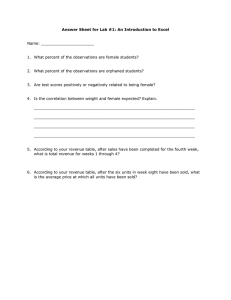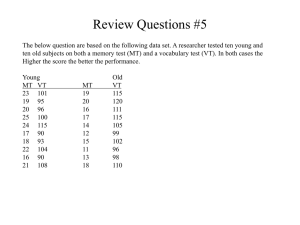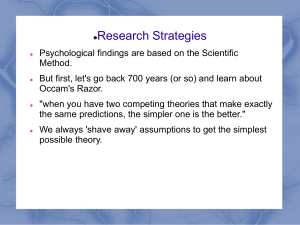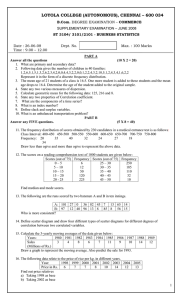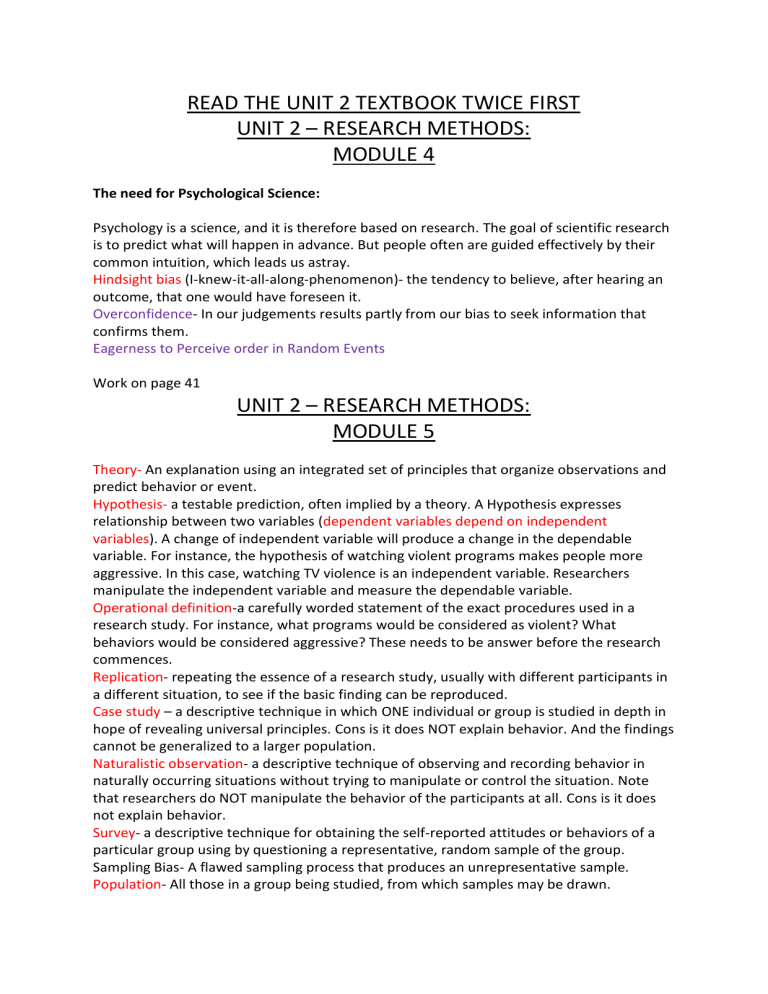
READ THE UNIT 2 TEXTBOOK TWICE FIRST UNIT 2 – RESEARCH METHODS: MODULE 4 The need for Psychological Science: Psychology is a science, and it is therefore based on research. The goal of scientific research is to predict what will happen in advance. But people often are guided effectively by their common intuition, which leads us astray. Hindsight bias (I-knew-it-all-along-phenomenon)- the tendency to believe, after hearing an outcome, that one would have foreseen it. Overconfidence- In our judgements results partly from our bias to seek information that confirms them. Eagerness to Perceive order in Random Events Work on page 41 UNIT 2 – RESEARCH METHODS: MODULE 5 Theory- An explanation using an integrated set of principles that organize observations and predict behavior or event. Hypothesis- a testable prediction, often implied by a theory. A Hypothesis expresses relationship between two variables (dependent variables depend on independent variables). A change of independent variable will produce a change in the dependable variable. For instance, the hypothesis of watching violent programs makes people more aggressive. In this case, watching TV violence is an independent variable. Researchers manipulate the independent variable and measure the dependable variable. Operational definition-a carefully worded statement of the exact procedures used in a research study. For instance, what programs would be considered as violent? What behaviors would be considered aggressive? These needs to be answer before the research commences. Replication- repeating the essence of a research study, usually with different participants in a different situation, to see if the basic finding can be reproduced. Case study – a descriptive technique in which ONE individual or group is studied in depth in hope of revealing universal principles. Cons is it does NOT explain behavior. And the findings cannot be generalized to a larger population. Naturalistic observation- a descriptive technique of observing and recording behavior in naturally occurring situations without trying to manipulate or control the situation. Note that researchers do NOT manipulate the behavior of the participants at all. Cons is it does not explain behavior. Survey- a descriptive technique for obtaining the self-reported attitudes or behaviors of a particular group using by questioning a representative, random sample of the group. Sampling Bias- A flawed sampling process that produces an unrepresentative sample. Population- All those in a group being studied, from which samples may be drawn. Random sample- a sample that fairly represents a population because each member has an equal chance of inclusion. Work on page 48 and 49. UNIT 2 – RESEARCH METHODS: MODULE 6 Correlation: (mixed with Barrons) Naturalistic observation and survey often show us that one trait or behavior needs to coincide with another. We say they correlate. A statistical measure, correlation coefficient (a statistical index of the relationship between two things from -1.00 to +1.00) helps us figure how closely two variables vary together and therefore how well either one predicts the other. Scatterplots shows pattern of correlation. Perfect correlation rarely occurs in the real world. A correlation is positive when two set of variables tend to rise or fall together. It means the presence of one thing predicts the presence of the other. Correlation is negative if two set of variables relate inversely, one go up as the other go down. It means the presence of one thing predicts the absence of the other. Correlation DOES NOT prove causation. Only suggests a possible cause – effect relationship but does not prove it. Correlations may be strong or weak. The strength of a correlation can be computed by a statistic called the correlation coefficient. Correlation coefficients range from -1 and +1 where -1 is a perfect negative correlation and +1 is a perfect positive correlation. Both -1 and +1 denote equally strong correlations. The number 0 denotes the weakest possible correlation- no correlation- which means that knowing something about one variable tells you nothing about the other. Correlation may be graphed using scatter plot. The line of best fit or regression line is a line drawn through the scatter plot that minimizes the distance of all points from the line. When the line slope upwards from upward from left to right, it indicates a positive correlation. A downward slope evidences a negative correlation. Illusory Correlation – perceiving a relationship where none exists or perceiving a strangest than actual relationship. Experimentation: Can identify cause-and-effect relationship Experiment- a research method which an investigator manipulates one nor more independent variable to observe the effect on some behavior or mental process (the dependable variable). Experimental group – is exposed to the treatment that is to the one version of the independent variable. Control group- the group NOT exposed to the treatment, contrasts with the experimental group and serves as a comparison for evaluating the effect of the treatment. Random assignment – assigning participants to experimental and control group by chance, so minimizing preexisting differences between the different groups. Confounding variable – Any difference between the experimental and control conditions, except for the independent variable that may affect the dependent variable. It means that other factor that can potentially influence a study’s result. Experimenter Bias- A confounding variable, the unconscious tendency for researcher to treat members of the experimental and control group differently to increase the chance of confirming their hypothesis. Placebo method – Whenever participants in the experimental group is supposed to ingest a drug, participants in the control groups are given an inert but otherwise identical substance. This technique allows researchers to separate the physiological effects of the drug from psychological effects of people thinking they took the drug (placebo effect). Validity: Good research is both valid and reliable. Research is valid when it measures what the researcher set out to measure; it is accurate. Research is reliable when it can be replicated, and it is consistent. Double-blind procedure-When neither the participants nor the researcher is able to affect the outcome of the research. For instance, none of them know which group is going to receive the treatment or placebo. Single blind procedure- When ONLY the participants do NOT know to which group, they have been assigned, minimizing participant bias. Work on page 58 UNIT 2 – RESEARCH METHODS: MODULE 7 Comparing Research methods: Research Purpose Method Descriptive To observe and record behavior Correlational To detect naturally occurring relationship, to assess how well one variable predicts another To explore cause and effect Experimental How conducted What is manipulated Weakness Case studies, naturalistic observation or surveys Collect data on two or more variables Nothing No control of variables, single case is not representative Can NOT specify cause and effect Use random assignment, manipulate one or more variables Independent variables Nothing Sometimes not feasible, results may not generalize to other context, not ethical to manipulate certain variables. How can simplified laboratory conditions illuminate everyday life? Researchers intentionally create a controlled, artificial environment in the lab in order to test general theoretical principles. These general principles help explain everyday behaviors. APA Ethical guidelines: (from Barrons) Ethical considerations are a major component in research design. Ethical guidelines established by APA for human and animal research and be prepared to apply the concepts to specific research designs. Any type of academic research must first propose the study to the ethics board or Institutional Review Board (IRB) at the institution. The IRB reviews research proposals for ethical violations and procedural errors. This board ultimately gives researchers permission to go ahead with the research or requires them to revise the procedure. Animal Research: (from Barrons) Groups advocating the ethical treatment of animals are focusing more and more attention on how animals are treated in laboratory experiments. The APA developed strict guidelines about what animals and how animals can be used in psychological research. Ethical psychological studies using animals must meet the following requirements: -Research must have a clear scientific purpose. -Research must answer a specific important scientific question. -Animal chosen must be best -suited to answer the question at hand. -Researchers must care for and house animals in a humane way. -Researchers must acquire animal subjects legally. Animals must be purchased from accredited companies. If wild animals must be used, they need to be trapped in a humane manner. -Researchers must design experimental procedures that employ the least amount of suffering feasible. Human Research: (from Barrons) Research involving human subjects must meet the following standards: -No coercion: Participation should be voluntary. -Informed Consent: Giving potential participants enough information about a study to enable them to choose whether they wish to participants. In other words, participants must know that they are involved in research and give their consent. If the participants are deceived in any way about the nature of the study, the deception must not be so extreme as to invalidate the informed consent. -Anonymity or Confidentiality: Participants’ privacy must be protected. Their identity and actions must not be revealed by the researcher. Participants have anonymity when the researchers do not collect any data that enable them to match a person’s responses to his or her name. In such cases, such as interview studies, a researcher cannot promise anonymity but instead guarantees confidentiality, that the researcher will not identify the source of the data. -Risk: Participants cannot be placed at significant mental or physical risk. It is considered permissible for them to experience temporary discomfort or stress but activities that might cause someone long-term mental or physical harm must be avoided. -Debriefing: AFTER the study, particpants should be told the purpose of the study and provided with ways to contact the researchers about the results. When research involve temporary deception, it is particularly important to conduct a thorough debriefing. How do values affect psychological science? Psychologists’ value influence their choice of research topics, their theories and observations, their labels for behaviors and their professional advice. The applications of psychology’s principles have been used mainly in the service of humanity. Work on page 64, 65 UNIT 2 – RESEARCH METHODS: MODULE 8 Descriptive Statistics: (from Barrons) Descriptive Statistics are numerical data used to measure and describe characteristics of groups. Includes measure of tendency and measure of variation. Histogram is a bar graph depicting a frequency distribution. Measure of central tendency attempts to mark the center of distribution. Three common measures of central tendency are mean, median and mode. The mean is the most commonly used measure of central tendency, but its accuracy can be distorted by extreme scores or outliers. For instance, 19 of 20 friends drive cars value at $12,000, but the other friend has a Maserati valued at $120,000. When a distribution includes outliers, the median is often used as a better measure of central tendency. Unless a distribution is symmetrical, it is skewed. Outliers skew distributions. When a distribution includes an extreme score (or group of scores) that is very high, the distribution is said to be positively skewed. When the skew is caused by a particularly low score (or group of scores), the distribution is negatively skewed. A positively skewed distribution contains more low scores than high scores. Conversely, a negative skewed distribution contains more high scores than low scores. In a positively skewed distribution, the mean is higher than the median because the outliers have a much more dramatic effect on the mean than on the median. Of course, the opposite is true in a negatively skewed distribution. Measures of variation: Range-The difference between the highest and lowest scores in a distribution. Standard Deviation – A computed measure of how much scores vary around the mean score. Please know how to calculate the standard deviation! Normal Curve – Normal distribution, a symmetrical bell-shaped curve that describes the distribution of many types of data; most scores fall near the mean and fewer near the extremes. Z scores (from Barrons)- Measures the distance of a score from the mean in units of standard deviation. Scores below the mean have negative z scores while scores above the mean have positive z score. Percentiles- the distance of a score from 0. Someone who scores at the 50th percentile has a z score of 0. Inferential Statistics: (from Barrons) The purpose of inferential statistics is to determine whether or not findings can be applied to the larger population from which the sample was selected. Remember that one of the primary goals in selecting a sample is that the sample represents the population from which it was picked. If a sample does not represent the larger population, one cannot infer anything about the larger population from the sample. Guaranteeing that a sample is representative of a population is impossible. The extent to which the sample differs from the population is known as sampling error. When the sample averages are reliable and when the difference between them is relatively large, we say the difference has statistical significance. Meaning that the observed difference is probably not due to chance variation between samples. How do we know whether an observed difference can be generalized to other population? To feel confident about generalizing an observed difference to other populations, we would need to know that the difference was reliable and also significant. Reliable differences are based on samples that: 1) are representative of the larger population being studied. 2) demonstrate low variability on average and 3) consist of many cases. We can say that an observed difference has statistical significance if the sample averages are reliable and when the difference between them is large. Now work on page 73-77.
